How much is it中职英语基础模块 第1册Unit 3高教版1
- 格式:ppt
- 大小:4.30 MB
- 文档页数:28
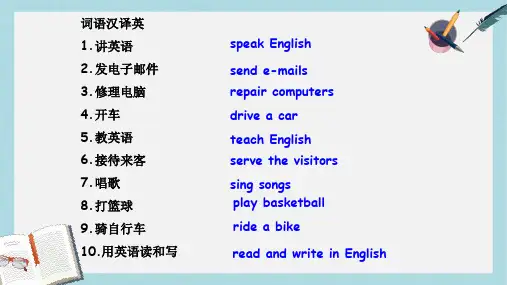
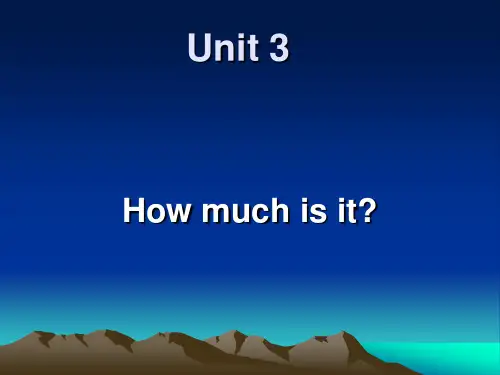
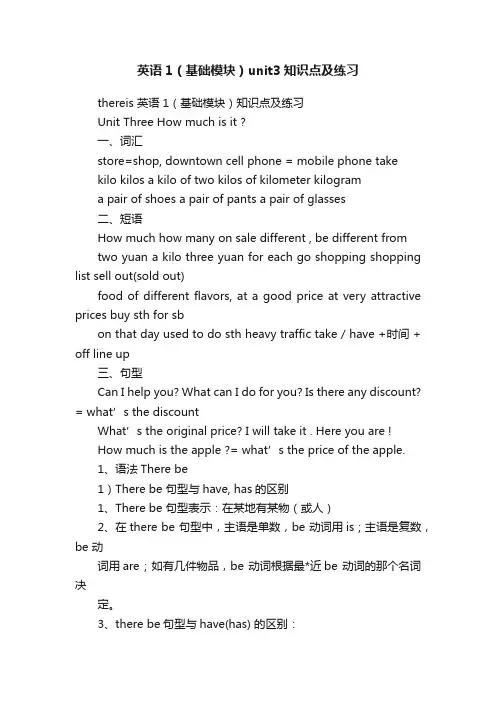
英语1(基础模块)unit3知识点及练习thereis 英语1(基础模块)知识点及练习Unit Three How much is it ?一、词汇store=shop, downtown cell phone = mobile phone takekilo kilos a kilo of two kilos of kilometer kilograma pair of shoes a pair of pants a pair of glasses二、短语How much how many on sale different , be different fromtwo yuan a kilo three yuan for each go shopping shopping list sell out(sold out)food of different flavors, at a good price at very attractive prices buy sth for sbon that day used to do sth heavy traffic take / have +时间 + off line up三、句型Can I help you? What can I do for you? Is there any discount? = what’s the discountWhat’s the original price? I will take it . Here you are !How much is the app le ?= what’s the price of the apple.1、语法There be1)There be 句型与have, has的区别1、There be 句型表示:在某地有某物(或人)2、在there be 句型中,主语是单数,be 动词用is ; 主语是复数,be 动词用are ; 如有几件物品,be 动词根据最*近be 动词的那个名词决定。
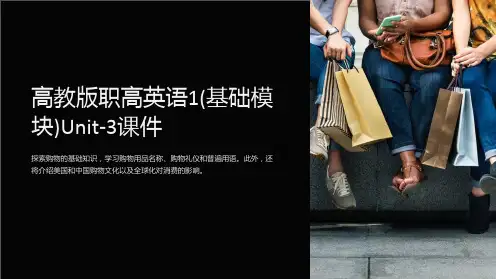
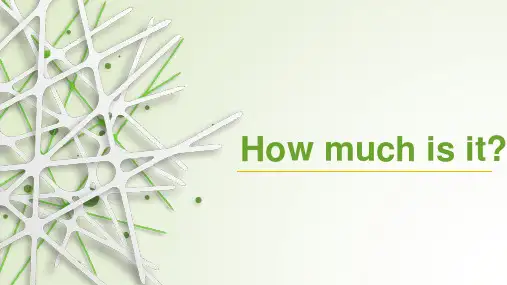
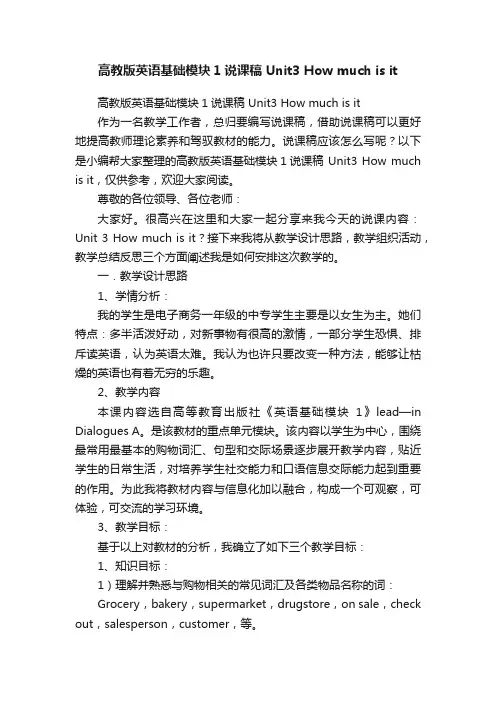
高教版英语基础模块1说课稿 Unit3 How much is it高教版英语基础模块1说课稿 Unit3 How much is it作为一名教学工作者,总归要编写说课稿,借助说课稿可以更好地提高教师理论素养和驾驭教材的能力。
说课稿应该怎么写呢?以下是小编帮大家整理的高教版英语基础模块1说课稿 Unit3 How much is it,仅供参考,欢迎大家阅读。
尊敬的各位领导、各位老师:大家好。
很高兴在这里和大家一起分享来我今天的说课内容:Unit 3 How much is it?接下来我将从教学设计思路,教学组织活动,教学总结反思三个方面阐述我是如何安排这次教学的。
一.教学设计思路1、学情分析:我的学生是电子商务一年级的中专学生主要是以女生为主。
她们特点:多半活泼好动,对新事物有很高的激情,一部分学生恐惧、排斥读英语,认为英语太难。
我认为也许只要改变一种方法,能够让枯燥的英语也有着无穷的乐趣。
2、教学内容本课内容选自高等教育出版社《英语基础模块1》lead—in Dialogues A。
是该教材的重点单元模块。
该内容以学生为中心,围绕最常用最基本的购物词汇、句型和交际场景逐步展开教学内容,贴近学生的日常生活,对培养学生社交能力和口语信息交际能力起到重要的作用。
为此我将教材内容与信息化加以融合,构成一个可观察,可体验,可交流的学习环境。
3、教学目标:基于以上对教材的分析,我确立了如下三个教学目标:1、知识目标:1)理解并熟悉与购物相关的常见词汇及各类物品名称的词:Grocery,bakery,supermarket,drugstore,on sale,check out,salesperson,customer,等。
2)学生能掌握讨论购物计划时所使用的句型,如:What’s your plan for…?Would you like to go shopping with me?What’s on your shopping list?I want to buy sth.I’d like to buy sth.what can I do for you?How much?等。
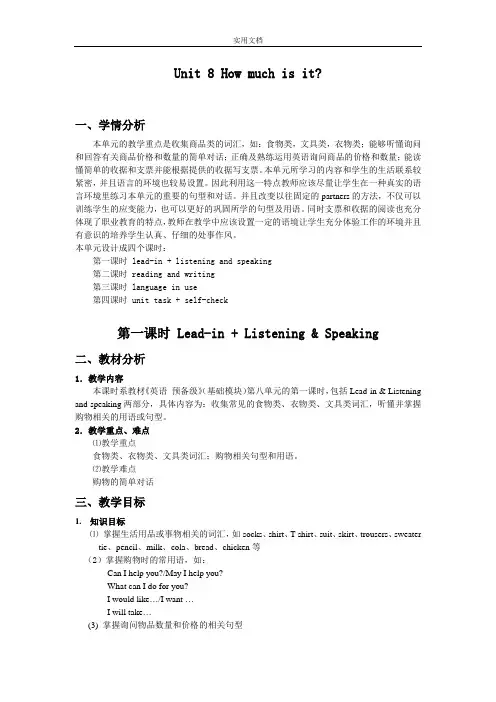
Unit 8 How much is it?一、学情分析本单元的教学重点是收集商品类的词汇,如:食物类,文具类,衣物类;能够听懂询问和回答有关商品价格和数量的简单对话;正确及熟练运用英语询问商品的价格和数量;能读懂简单的收据和支票并能根据提供的收据写支票。
本单元所学习的内容和学生的生活联系较紧密,并且语言的环境也较易设置。
因此利用这一特点教师应该尽量让学生在一种真实的语言环境里练习本单元的重要的句型和对话。
并且改变以往固定的partners的方法,不仅可以训练学生的应变能力,也可以更好的巩固所学的句型及用语。
同时支票和收据的阅读也充分体现了职业教育的特点,教师在教学中应该设置一定的语境让学生充分体验工作的环境并且有意识的培养学生认真、仔细的处事作风。
本单元设计成四个课时:第一课时 lead-in + listening and speaking第二课时 reading and writing第三课时 language in use第四课时 unit task + self-check第一课时 Lead-in + Listening & Speaking二、教材分析1.教学内容本课时系教材《英语预备级》(基础模块)第八单元的第一课时,包括Lead-in & Listening and speaking两部分,具体内容为:收集常见的食物类、衣物类、文具类词汇,听懂并掌握购物相关的用语或句型。
2.教学重点、难点⑴教学重点食物类、衣物类、文具类词汇;购物相关句型和用语。
⑵教学难点购物的简单对话三、教学目标1.知识目标⑴掌握生活用品或事物相关的词汇,如socks、shirt、T-shirt、suit、skirt、trousers、sweatertie、pencil、milk、cola、bread、chicken等(2)掌握购物时的常用语,如:Can I help you?/May I help you?What can I do for you?I would like…/I want …I will take…(3) 掌握询问物品数量和价格的相关句型How much is it? / How much are they?How much do you want? / How many do you want2.能力目标⑴学生能听懂简单的购物相关对话。
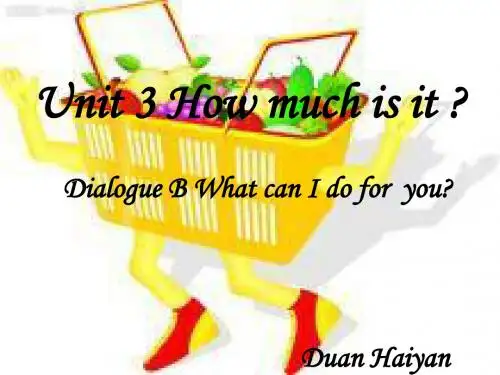
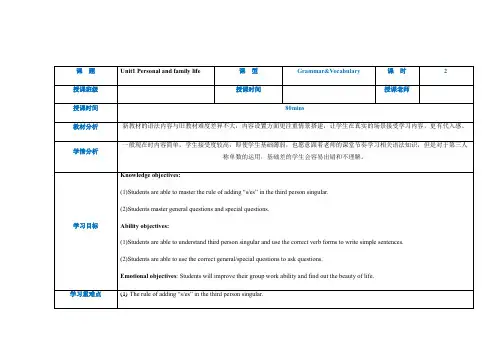
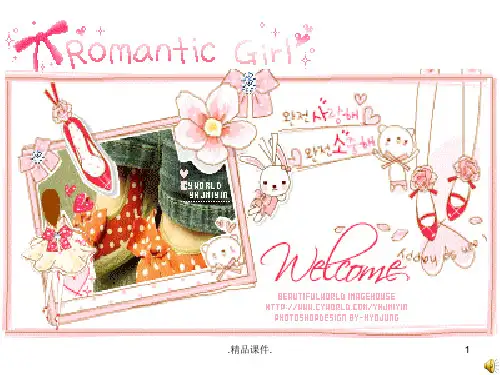
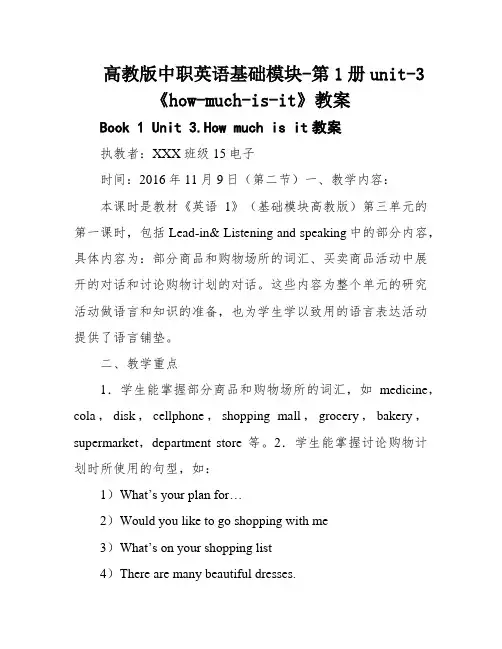
高教版中职英语基础模块-第1册unit-3《how-much-is-it》教案Book 1 Unit 3.How much is it教案执教者:XXX班级15电子时间:2016年11月9日(第二节)一、教学内容:本课时是教材《英语1》(基础模块高教版)第三单元的第一课时,包括Lead-in& Listening and speaking中的部分内容,具体内容为:部分商品和购物场所的词汇、买卖商品活动中展开的对话和讨论购物计划的对话。
这些内容为整个单元的研究活动做语言和知识的准备,也为学生学以致用的语言表达活动提供了语言铺垫。
二、教学重点1.学生能掌握部分商品和购物场所的词汇,如medicine,cola,disk,cellphone,shopping mall,grocery,bakery,supermarket,department store等。
2.学生能掌握讨论购物计划时所使用的句型,如:1)What’s your plan for…2)Would you like to go shopping with me3)What’s on your shopping list4)There are many beautiful dresses.3.通过创设情境,学以致用,使学生能够用以下句型在购物场所进行买卖商品的对话。
1)Can I help youWhat can I do for you2)I want to buy a/an/some+某物.I’d like to buy a/an/some +某物.3)How much is /are +某物What’s the price of+某物It’s +价钱./They’re +价钱.4)It’s on sale now.5)I’ll take 5 kilos.3、教学难点:(1)学生能听懂关于购物和讨论购物打算的对话。
(2)学生可以创设情境展开关于讨论购物打算的对话。
Unit 3 How much is it ?一. 知识点1. 营业员:①What can I do for you? ②Can I help you?③Anything I can do for you? ④How can I help you?2. 顾客:①I’d like sth. ②I want sth.I’d like to buy sth. I want to buy sth.③I’m looking for….3.谈论价格:①A:How much is the orange? B: 2 yuan a kilo. It’s on sale today.②A:Is there any discount? B: Yes, it’s on a sharp discount.A:I’ll take 5 kilos③The price is high / low. (Sth. is expensive/ cheap.)④at an attractive price / at the price of five dollars4. sell out 售完be sold out 被动结构. All bananas are sold out.5. Black Friday used to mean heavy traffic. used to do sth. 过去常常做某事6. Many people would take the day off to go shopping, because many things are on sharpdiscount①on sharp discount 大幅打折②go sho pp ing 购物③take off 脱掉Why don’t you t ake off your jacket?起飞The plane takes off at 5 o’clock请假I’ll take Friday off so we can leave on Thursday二. 语法:There be结构定义:There be句型表示“某处(或某时)有(或存在)某物或某人。
澄江县职业高级中学杨丽娟Unit 3 How much is it?(第二课时教学设计)一、教材分析1.教学内容本课时系教材《英语1》(基础模块高教版)第三单元的第二课时,授课材料为Listening and speaking中的Dialogue B,具体内容包括:关于商品信息的词汇、买卖商品活动中售货员和顾客展开的对话,如售货员接待顾客、介绍商品有无及折扣,顾客询问商品价格、表达购买数量等内容。
以上内容为本单元听说课的教学重点,也为学生学以致用的语言表达活动提供了语言铺垫。
同时,本课时的教学内容为学生完成单元任务——运用本课所学知识举办一次旧书展卖会做出语言和行为示范。
2.教学重点、难点⑴教学重点通过顾客与售货员之间对话的学习,学生能自如地询问商品信息,表达购物需求,并恰当回应。
⑵教学难点学生运用提高听力效果的策略——以表格形式记录关键信息。
学生理解购物发票各项目的含义。
二、教学目标1.知识目标⑴学生能理解关于商品信息的词汇,如quantity, unit price, amount, signature, kilo, onsale。
⑵学生能掌握顾客与售货员之间对话的句型,如:What can I do for you?I’d like to buy….Sorry, …are sold out. / Sorry, there aren’t any….How much is / are…?2 yuan a kilo.It’s on sale now.I will take 5 kilos.2.能力目标⑴学生能听懂顾客和售货员之间买卖商品的对话。
⑵学生能开展关于买卖商品的对话。
(3)学生通过预测和记录关键信息的策略提高听力水平。
3.情感目标学生了解售货员及顾客的礼仪并会在实际生活中应用。
三、教学步骤Step One Picture description1.Picture showTeacher shows Picture 1 from Activity 21 on the screen,and adds more information on it, e.g. Wood’s Bakery, No. 2 V ocational School, Tang Hua, Jerry Shade, a calendar. Students have a look at the picture for 5 seconds.Step Two Listening (Activity 7, 8)Activity 7. Bingo!1.Teacher explains the rules: Tang Hua is in the bakery. He wants to buy some food. But something is sold out. What’ it? Look at the pictures in Acti vity 7 and tick the goods that you think is sold out. Then we listen to the dialogue. If you get right guess, you say Bingo. Let’s see which group gets the most Bingo. I wish you good luck!Then students tick the goods, listen to the dialogue and check answers.2. True or false exercises.1) Tang Hua wants to buy some bread and pizza. ( ×)2) The cakes are on sale now. ( √)3) Tang Hua buys some cakes and pizza at last. ( √)3. Activity 8. Listen and complete.Students discuss the invoice with their partner, and try to get to know the meaning of the following words on the invoice by themselves: item, quantity, unit price, amount, signature. Then ask one or two students to explain the words.Teacher introduces a tip on how to make the listening activity more efficient: Write down the key words of a dialogue in a form.Students listen to the dialogue and finish the invoice individually. Then the whole class checkthe answers together.Listen again if necessary.Step Three Speaking (Activity 9 , 10, 11)1. Read and underline.Students read the dialogue in Activity 9 individually, then underline the sentences about shopping. Teacher asks 2 or 3 students to tell others their choices, and writes down the sentences on the blackboard:2.Read the dialogue together.Students read the dialogue twice together. The first time is between two groups, and the second is between boys and girls.3. Performance: Shopping in the stationary!(1) Y ou want buy some stationary. Invite one of your friend to go shopping with you.(2) Three students form a group. They get ready in 5 minutes, then 3 or 4 groups show the play on the stage.4.Discussion: What manners are important when we serve the customers as salespersons?Students may discuss the topic with partners. Then they give their ideas with sentences, phrases or even body languages.Step Four Homework四、板书设计。
阿克苏职业技术学院单元教学设计方案Step two: Lead-in1. Draw into the activity and give the examples.2. Ask some students to discuss the answers according to the pictures on the book.3. Give the students some new words about the pictures and ask the studentsto practice the pronunciation of them.Step three :Listening1. Give the students some sentences and ask the students to find out the words about shopping.2. Display the important words, expressions and sentences.words and expressions: plan, go shopping, sell out, on sale, take, welcome, flavor, attractive, best, unit price, drugstore, grocery, bakery, supermarket, quantity, signature, salesperson, delicious, kilo, item …2)about shopping: What’s your plan for…? / Do you have anything to do … ? /Would you like to go shopping with me? / Good idea! / Great! /What’s on your shopping list? / I want … / I want to buy …SentencesA : Oh, so many kinds of winter hats.B : What is your favorite color , miss?A : Red.B : Here you are. It's very attractive.A : May I try it on ?II教学过程设计(III)(按照两课时的教学内容任务编写)。